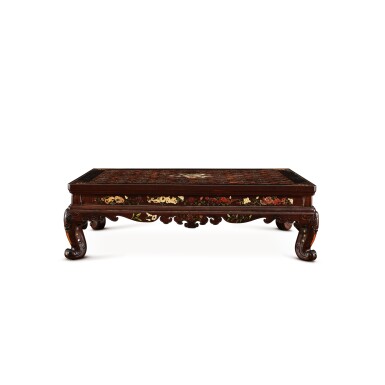Important Chinese Art
Important Chinese Art

A hardstone-inlaid zitan low table, kangzhuo, Qing dynasty, Kangxi period | 清康熙 紫檀百納鑲面百寶嵌螭龍花卉紋高束腰炕桌
Premium Lot
Auction Closed
October 9, 09:17 AM GMT
Estimate
6,000,000 - 8,000,000 HKD
Lot Details
Description
A hardstone-inlaid zitan low table, kangzhuo,
Qing dynasty, Kangxi period
清康熙 紫檀百納鑲面百寶嵌螭龍花卉紋高束腰炕桌
100 by 69.5 by h. 30.5 cm
As Wang Shixiang notes, a wide kang table like this piece will be positioned in the middle of a kang, a raised bed-like platform but against a wall, or on the centre of a traditional bed, creating a comfortable and intimate space for close friends. This set-up is evident in an illustration of a Yuan dynasty woodblock print Shilin guang ji (Compendium of a Forest of Affairs), where a low table is depicted in the centre of the bed with two people engaged in the Double Sixes game, see Sarah Handler, Austere Luminosity of Chinese Classical Furniture, Berkeley, 2001, fig. 9.7, p. 126.
This piece is particularly notable for its lavish use of precious stones and its exceptionally sophisticated inlay technique, epitomising its fine craftsmanship featuring Qing-style furniture. The tabletop uses the flush inlay technique to maintain a flat surface, while the waists and aprons feature a protruding inlay method, providing a three-dimensional, sculptural effect. The inlaid decoration is commonly applied on lacquer furniture, but examples of hardwood are rare, even in the imperial palace. See a kang cabinet made with huali wood and decorated in protruding style inlays, illustrated in Hu Desheng, A Treasury of Ming & Qing Dynasty Palace Furniture, vol. 1, Beijing and Chicago, 2007, p. 321, pl. 360.
In addition to its rich inlay of precious stones, the table is distinctive for the four robust legs in the form of curved elephant trunks. Such a design is more frequently found on incense burners in the Ming and Qing courts; see, for example, a cloisonné incense burner with three elephant-head legs, from the Beijing Palace Museum, illustrated in Gugong Bowuyuan cangpin daxi: falang qi bian / Compendium of Collections in the Palace Museum. Enamels, vol. 2, Beijing, 2011, pl. 5. The design of cabriole legs itself also has a Ming origin, as seen in a waisted kang table made of huanghuali wood, illustrated in Wang Shixiang, Classic Chinese Furniture. Ming and Early Qing Dynasties, London, 1986, pp. 116-117, pl. 65.
Compare a related kang table made of zitan, with the tabletop edge, waist and legs extensively carved in high relief, from the Palace Museum, Beijing, illustrated in Hu Desheng, op. cit., fig. 274, p. 242. See also two related examples, one in black lacquer and decorated with inlaid jade; the other in cinnabar lacquer and decorated with mother-of-pearl, both from the Qing imperial collection and now in the Palace Museum, Beijing, illustrated in Gugong Bowuyuan cang wenwu zhenpin quanji. Ming Qing jiaju. Xia / The Complete Collection of Treasures of the Palace Museum. Furniture of the Ming and Qing Dynasties (II), Hong Kong, 2002, pls 121 and 122. The latter piece was once positioned in the west room of the Chuxiu Palace (Palace of Gathering Excellence) in the Palace Museum, Beijing, captured in a photograph, illustrated in op. cit. 2002, pl. 251, providing insights into the actual use of such kang zhuo in the imperial court. Compare also a similar kang table of this type, sold in these rooms, 31st October 2004, lot 17, and subsequently entered the Xianquxuan Collection and illustrated in The Grandeur of Chinese Art Treasures: Min Chiu Society Golden Jubilee Exhibition, Hong Kong Museum of Art, Hong Kong, 2010, cat. no. 333.
炕桌高束腰,須彌座式,三彎腿,外翻馬蹄。以紫檀而製,桌面百納鑲工藝,工藝精湛,通體嵌百寶,雕嵌精美,富麗華貴。桌面寬闊,四邊做出冰裂紋,四角留原木色。面心以不同顏色的木片和材質雕嵌蓮花及如意雲頭紋飾,面心中間菱形開光內以彩色玉石鑲嵌飛龍紋。桌沿邊設水線,四角鎪出委角。底部髹朱漆,見三根穿帶支承。束腰處嵌彩色玉石螭龍紋。牙板起線流暢,沿邊陽線亦雕刻精細,延伸至腿足。牙板上以百寶嵌工藝鑲嵌折枝花卉。下承三彎腿,足底外翻馬蹄。三彎腿上以相同工藝飾圓形柳丁紋,與卷卷草紋相互呼應。整器選料珍貴,雕嵌精美,造型雄偉,線條遒勁,在炕桌中堪稱佳制。百寶嵌工藝常見於漆器,以硬木鑲嵌之例則很少見,只有清宮舊藏中偶見類似,參見胡德生,《明清宮廷傢具大觀》,第一冊,北京和芝加哥,2007年,頁321,圖360。
王世襄先生曾對此類炕桌置放位置及功能做過相關論述,認為即可依憑靠倚,亦可放置器物或用於享宴,元代木刻版畫《事林廣記》的插圖中便有類似的描繪,參見Sarah Handler,《Austere Luminosity of Chinese Classical Furniture》,伯克利,2001年,圖9.7,頁126。
此炕桌三彎腿的設計在清宮掐絲琺瑯器上也有所借鑒,如北京故宮博物院藏一件的掐絲琺瑯香爐,參見《故宮博物院藏品大系:琺瑯器編》,卷2,北京,2011年,圖5。而此種設計最早應源於明式傢具,見黃花梨炕桌一例,見王世襄,《Classic Chinese Furniture. Ming and Early Qing Dynasties》,倫敦,1986年,頁116-117,圖65。
類似的紫檀炕桌,見北京故宮博物院藏一例,其桌面邊緣、束腰及四腿皆有浮雕裝飾,雕刻精緻,見於胡德生,前述著錄,圖274,頁242。另見兩例宮廷使用炕桌,一為黑漆嵌玉;另一個是硃漆嵌螺鈿,均來自清宮舊藏,現存於北京故宮博物院,見《故宮博物院藏品大系·明清傢具(二)》,香港,2002年,圖版121和122。後者曾經放置於儲秀宮梢間,見於前著錄,2002年,圖版251,可見此類炕桌在清宮中使用的情況。另見一例非常相似之例,售於香港蘇富比,2004年10月31日,拍賣品號17,後為閒趣軒收藏,著錄於《博古存珍: 敏求精舍金禧紀念展》,香港藝術館,香港,2010年,編號333。
